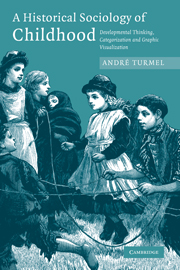 A Historical Sociology of Childhood
A Historical Sociology of Childhood Published online by Cambridge University Press: 22 September 2009
By the 1920s and 1930s, development was not only an outlandish idea emerging from researchers in isolated laboratories. It was, more broadly, becoming both a way of thinking and acting legitimized in the scientific community and in the larger childhood collective; thus, slowly percolating several activities pertaining to childhood. Growth, which chiefly means children's physical progression, was not any longer the central concern in the collective for the questions of hygiene, nutrition and so on were already on the agenda of experts and families, and mental hygiene was likewise becoming a crucial aspect of children's lives, therefore extending widely the emerging concept of development.
It is understood that developmental thinking paved the way to the idea of the normal child, to which it is tied by numerous connections, as much mental and physical normality with respect to the child's maturation. Based on statistical technologies in extensive focused enquiries, large-scale regularities contributed decisively to outline what a normal child would look like, both physically and mentally. Although normality was far from being unequivocal as a notion, different actors from the childhood collective – parents, teachers, paediatricians, nurses and welfare activists, social workers – started to be on the look-out for new criteria that would be suitable for adults in their daily relations with children. Developmental standards were implemented in the collective; thus, children's progression was measured in accordance with these standards. Moreover, parents, teachers and the like gradually fell in line with this particular way of thinking.
To save this book to your Kindle, first ensure no-reply@cambridge.org is added to your Approved Personal Document E-mail List under your Personal Document Settings on the Manage Your Content and Devices page of your Amazon account. Then enter the ‘name’ part of your Kindle email address below. Find out more about saving to your Kindle.
Note you can select to save to either the @free.kindle.com or @kindle.com variations. ‘@free.kindle.com’ emails are free but can only be saved to your device when it is connected to wi-fi. ‘@kindle.com’ emails can be delivered even when you are not connected to wi-fi, but note that service fees apply.
Find out more about the Kindle Personal Document Service.
To save content items to your account, please confirm that you agree to abide by our usage policies. If this is the first time you use this feature, you will be asked to authorise Cambridge Core to connect with your account. Find out more about saving content to Dropbox.
To save content items to your account, please confirm that you agree to abide by our usage policies. If this is the first time you use this feature, you will be asked to authorise Cambridge Core to connect with your account. Find out more about saving content to Google Drive.